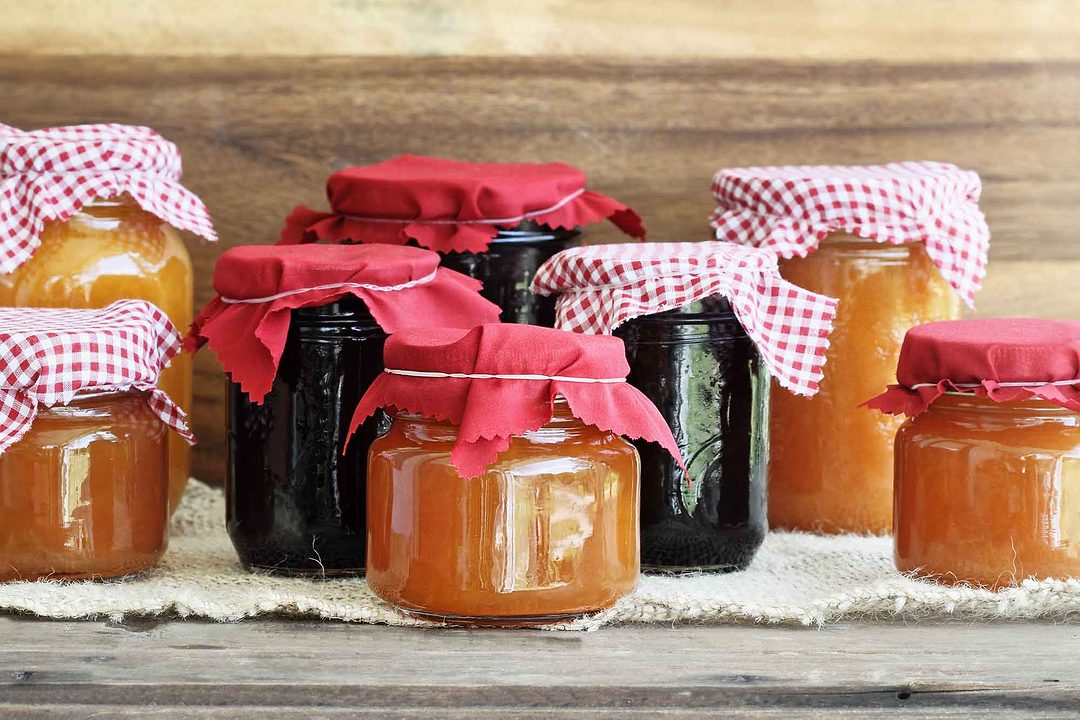Surviving a New England winter in the 1700s was no easy task. Food, shelter, firewood, and warm clothing were essential. One of the most important jobs of summer and fall was to preserve enough food to feed a family throughout the long winter months.
Today, if you are interested in preserving food the most common methods would be freezing, refrigeration, or canning. These methods are very similar to how colonists preserved food in the early 1700s, however their techniques were complicated by a lack of freezers and mason jars. The reason food preservation began, and remains necessary today, is exactly the same — keeping food safe by slowing down its molecular movement. When microorganisms are dormant the food remains edible. When the microorganisms grow, it changes the chemical composition within the food and then spoils the food. There are only a few cases when these changes are encouraged, most notably in cheese! Introducing the right type of bacteria and letting it develop is one way milk transforms into cheese.

Colonists preserved food using eight basic methods: fermentation, burial, drying, curing, cooling, freezing, pickling, and canning.
Fermentation happens when starches and sugars react with microorganisms and produce alcohol. Fall harvest arrives, grapes are plucked from the vines and apples from the orchards. Wine and cider production is now on its way. These beverages are then stored in the coolest part of the home or in a root cellar. This was one way in which colonists produced beverages that could be safely stored for long periods of time.
Burial was a common preservation technique. Meat is buried under hot coals. The lack of light, reduced oxygen, and heat from the coals kills harmful microorganisms, thus preserving the meat for consumption in later months. In addition, burying fresh eggs in sand or under layers of straw was a common practice. Straw is a good insulator and was frequently used to protect delicate foods from extreme temperatures. They would layer eggs with dry salt and lard to keep them from freezing and then cover them with straw, preserving them for up to a year. In addition, along the coastal areas burying oysters was common. Again, they placed the oysters deep in the sand to keep them fresh and edible over the winter months. During the shoulder seasons they would keep the oysters cold, housed in woven baskets, sitting on rivers near tidal pools with saltwater coming in and freshwater washing out.

Drying enables the preservation process because the water in food can become a breeding ground for microorganisms. When drying spices or vegetables the lack of water stops the microorganisms from spoiling the food. In addition, salt was used to preserve food as salt draws out the water in the food by osmosis, acting as a natural drying preservative. At harvest time many fruits and vegetables were dried, but one vegetable was especially common — corn. Corn was stored in dry storage bins and used in meals throughout the winter months.
Curing or smoking food deposits phenols, guaiacol, and catechol on the food. Thus, the food has a taste of smokiness and the food can remain edible for months after being smoked and held in a dry storeroom.
Cooling and freezing again focus on slowing down the molecular movement, causing microorganisms that spoil food to be dormant. Many times, food was put in caves or root cellars which held consistently cool temperatures even in the New England summers. To help keep temperatures down, ice blocks were wrapped in hay to keep root cellars cool - an early ‘refrigeration’ technique.

Pickling began by using wine or beer since both liquids have low pH levels and transform into vinegar. The alcohol in wine or beer is oxidized by certain bacteria and turns into acetic acid or vinegar. So, after the harvest cucumbers, peppers, beans, peas, and carrots were often pickled. Apples, peaches, and pears were some of the early fruits that were preserved through the pickling method as well.
Canning was used if glass jars were available. The process then was much like the process today. After harvest, the food was put in glass jars. The jars were sealed with cork and sealing wax and then placed in boiling water. The heating and cooling cycle creates a vacuum seal that prevents microorganisms from contaminating the food within the jar. Canning was a common preservation method for both fruits and vegetables.
Steve and Joan Verrill of Verrill Farm are well versed in food preservation techniques. “The art of preserving food is timeless,” Joan says. “What the colonists did is similar to what we do today. Each type of food dictates how, when, and what process you use to preserve it.” For example, they shared that grain, beans, potatoes, eggs, herbs, pumpkins, tomatoes, and onions need to be kept dry to be preserved. Root vegetables such as beets, carrots, winter squash, and turnips need to be kept in damp storage to be preserved for lengths of time. Joan shared that mixing honey and water and then submerging peaches and apples in the mixture keeps the fruit preserved for months at a time.
The art of food preservation is alive and well in Concord today. Many homes have gardens and root cellars. Each autumn Concord grapes are transformed into jam at my home. We can them using mason jars purchased years ago from our beloved West Concord Five and Ten which is now, sadly, closed. This preservation artform in our home is akin to deep violet deliciousness.
All photos istock.com


